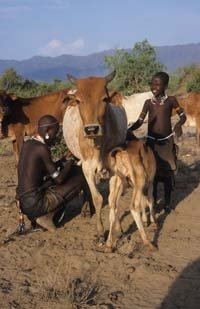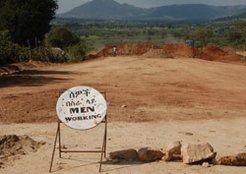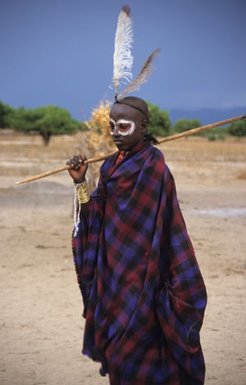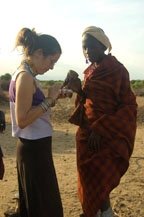Knowledge about War and Peace among the Arbore of Southern Ethiopia
“Why does she (Arbore) among all countries keep peace?
Arbore – this wicked old one – no one can reach her.
She isn’t afraid of war, is fighting.
She is fighting but she does not like war.”
(statement of an Arbore woman)

In the sorghum fields.
The Arbore are a Cushitic agro pastoral group of around 5,000 people living in the delta of the Woyto valley, north of Lake Stephanie (Chew Bahir) close to the Kenyan border in the South Omo Zone of Southwestern Ethiopia. The Arbore have been known as one of the many groups in Southern Ethiopia for which warfare and hunting formed an important element of cultural identity and cultural neighborhood. Since 1993 though the Arbore have deliberately developed ways to refrain from hostile activities such as raiding, interethnic warfare and blood feud. At the same time increasing forms of conflict induced by innovation and the influence of State politics lead to a shift of arenas for conflict resolution and their respective institutions. Based on field research in Arbore since 1993 and on topical workshops in the South Omo Museum and Research Center since 2000, the project will evaluate the present situation in a historical perspective regarding local and regional dynamics and state politics.
New arenas of conflict

The changes induced by a massive development plan of the Ethiopian government result in the ongoing integration of the South Omo region in the administrative, educational, economical and communication networks of the Ethiopian State. New goods as well as hitherto unfamiliar ideas and practices get introduced to the area with increased speed and higher frequency, evoking fantasies and hope as well as fears and feelings of uncertainty. The Arbore are facing these challenges by re-defining the modes of dealing with tempting as well as threatening factors of innovation and state politics.
For the evaluation of changes the concept of aada provides an important means of measure for the Arbore. Aada can be translated as custom, as tradition or simply as the right way of doing things. Changes induced by projects of NGO’s and missionaries but also individual behavior of Arbore who have been educated at state schools are discussed concerning their compatibility with aada. If people, projects or changes in general are perceived to be incompatible, they should be rejected or corrected.

In the project approach the concept of aada is not seen as a rigid form of traditionalism, but as an ongoing creative evaluation of new influences. This constant re-evaluation of own and other is part of a vital identity discourse. To picture this, the project describes arenas of change ranging between rejection and acceptance in case studies concerning activities of missionaries, NGOs, the State, tourists and anthropologists.
Peace and paradox

Being steadily peaceful for the Arbore not only is a change in a historical dimension but also in the regional context of South Omo. Warfare had been embedded in all spheres of Arbore everyday life and formed part of the relationships, shifting conflicts and alliances, with their neighbors. Warfare was controlled by institutions within the Arbore age set system with political authority based on seniority. Symbols (e.g. songs, adornment, speech acts) were constituted through killing acts and their vital value supported a killer ethos. War enhancing practices could be performed by all members of the society, often in ritualized forms and actions. As a lasting peace - not the longing for it - is a rather recent phenomenon, not all symbolic forms supporting a warlike identity have yet been adjusted to a peaceful self understanding and when looking at the present situation it naturally is rich in contradiction. These points of contradiction and how they are dealt with play part in the evaluation of the quality of the peace efforts.
For this part of the project, a focus on actors (elders, women and youth) and their motivations is taken to provide an “inventory of war enhancing practices” as a basis for an analysis of their re-evaluation in peaceful times.

Example: The oxymoron of the peaceful “warrior”
Boys and young men who are presently in their teens and twens form the first generation of Arbore who cannot fulfill an important part of their traditional way of “becoming” by achieving the status of a killer of men or of big game. At the same time they still identify with the killer status. The tension between cultural concepts of virility, the continuous display of respective identity markers and the present efforts to maintain peaceful can be found in many situations.
The project looks at individual reflections of young men within their group of age mates and connect them to discussions with elders. With the total rejection of war, the elders are the ones who block any possibilities to achieve the killer status. Decisions between diverging loyalties and ideals and new options for identification as well as possible formal equivalents or replacements of the “lost way” are discussed.
Peace, Persuasion and Performance

Peace is - rather than a stringent argument - a constant rhetoric effort of discussion and persuasion. When looking at rhetorical practices I will not only look at speech acts but also at the information carried in oral history especially in song lyrics. Music and song lyrics form an important part of Arbore oral history and present culture. Within the different ways and arenas of discussion they form an exclusive genre, where things that cannot be spoken about elsewhere, find a noticeable way of expression. As integral part of regular performances music provides a forum to identify the norms and values through which self and group understanding is created. Content and performance of songs are analyzed regarding their constitutive elements for motivations and identity formation to understand their meaning in the present period of peace.





